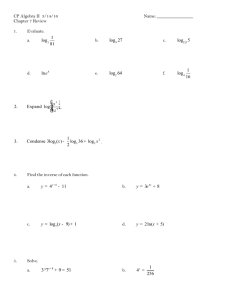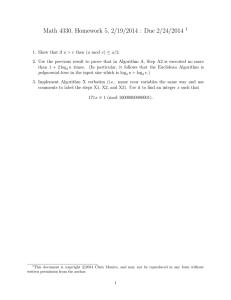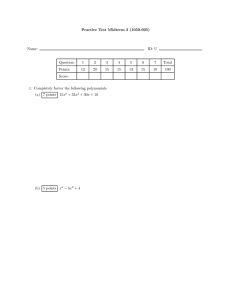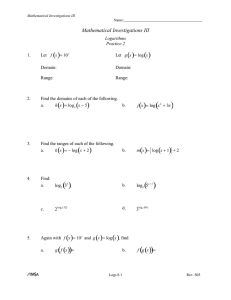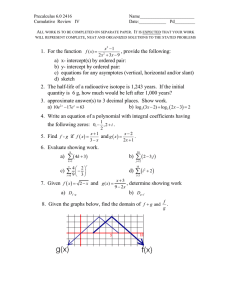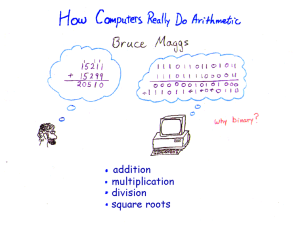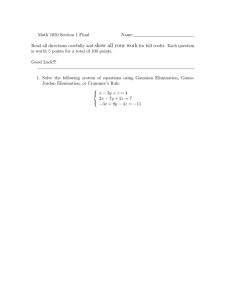ln(35
advertisement
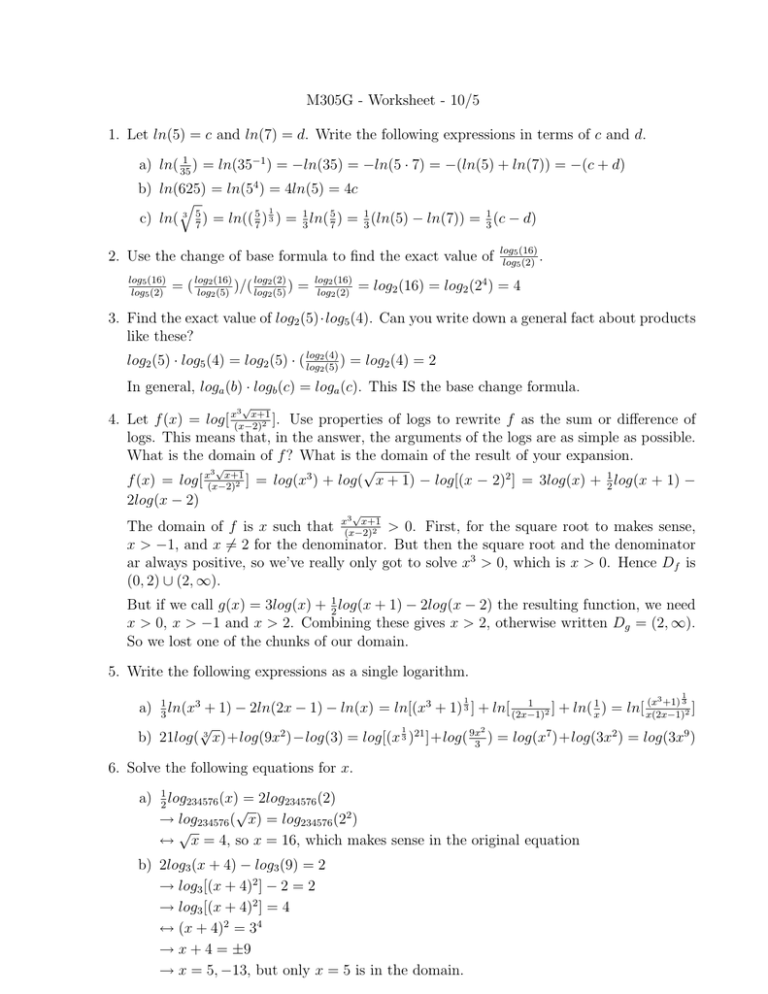
M305G - Worksheet - 10/5 1. Let ln(5) = c and ln(7) = d. Write the following expressions in terms of c and d. 1 a) ln( 35 ) = ln(35−1 ) = −ln(35) = −ln(5 · 7) = −(ln(5) + ln(7)) = −(c + d) b) ln(625) = ln(54 ) = 4ln(5) = 4c q 1 c) ln( 3 57 ) = ln(( 57 ) 3 ) = 13 ln( 75 ) = 13 (ln(5) − ln(7)) = 31 (c − d) 2. Use the change of base formula to find the exact value of log5 (16) log5 (2) log2 (2) 2 (16) = ( log )/( log )= log2 (5) 2 (5) log2 (16) log2 (2) log5 (16) . log5 (2) = log2 (16) = log2 (24 ) = 4 3. Find the exact value of log2 (5)·log5 (4). Can you write down a general fact about products like these? log2 (4) log2 (5) · log5 (4) = log2 (5) · ( log ) = log2 (4) = 2 2 (5) In general, loga (b) · logb (c) = loga (c). This IS the base change formula. 3 √ x+1 4. Let f (x) = log[ x(x−2) 2 ]. Use properties of logs to rewrite f as the sum or difference of logs. This means that, in the answer, the arguments of the logs are as simple as possible. What is the domain of f ? What is the domain of the result of your expansion. √ √ 3 x+1 3 x + 1) − log[(x − 2)2 ] = 3log(x) + 12 log(x + 1) − f (x) = log[ x(x−2) 2 ] = log(x ) + log( 2log(x − 2) 3 √ x+1 The domain of f is x such that x(x−2) 2 > 0. First, for the square root to makes sense, x > −1, and x 6= 2 for the denominator. But then the square root and the denominator ar always positive, so we’ve really only got to solve x3 > 0, which is x > 0. Hence Df is (0, 2) ∪ (2, ∞). But if we call g(x) = 3log(x) + 21 log(x + 1) − 2log(x − 2) the resulting function, we need x > 0, x > −1 and x > 2. Combining these gives x > 2, otherwise written Dg = (2, ∞). So we lost one of the chunks of our domain. 5. Write the following expressions as a single logarithm. 1 3 1 3 (x +1) 1 1 + 1) − 2ln(2x − 1) − ln(x) = ln[(x3 + 1) 3 ] + ln[ (2x−1) 2 ] + ln( x ) = ln[ x(2x−1)2 ] √ 1 2 b) 21log( 3 x)+log(9x2 )−log(3) = log[(x 3 )21 ]+log( 9x3 ) = log(x7 )+log(3x2 ) = log(3x9 ) a) 1 ln(x3 3 6. Solve the following equations for x. a) 1 log234576 (x) 2 = 2log234576 (2) √ → log234576 ( x) = log234576 (22 ) √ ↔ x = 4, so x = 16, which makes sense in the original equation b) 2log3 (x + 4) − log3 (9) = 2 → log3 [(x + 4)2 ] − 2 = 2 → log3 [(x + 4)2 ] = 4 ↔ (x + 4)2 = 34 → x + 4 = ±9 → x = 5, −13, but only x = 5 is in the domain. c) 22x + 2x+2 − 12 = 0 → (2x )2 + 22 (2x ) − 12 = 0, so let u = 2x → u2 + 4u − 12 = (u + 6)(u − 2) = 0, so u = 2, −6 → 2x = 2, which gives x = 1 or 2x = −6, which gives no solution. x = 1 makes sense in the original equation, so it is our only solution. d) ( 34 )1−x = 5x → ln[( 43 )1−x ] = ln(5x ) → (1 − x)ln( 34 ) = xln(5) → ln( 43 ) − xln( 34 ) = xln(5) ) → ln( 43 ) = xln(5) + xln( 34 ) = x(ln(5) + ln( 34 )) = xln( 20 3 → ln( 34 ) ln( 20 ) 3 = x, which makes sense in the original equation. e) loga (x − 1) − loga (x + 6) = loga (x − 2) − loga (x + 3) ) = loga ( x−2 ) → loga ( x−1 x+6 x+3 x−2 = x+3 → x−1 x+6 → (x − 1)(x + 3) = x2 + 2x − 3 = x2 + 4x − 12 = (x − 2)(x + 6) → 0 = 2x − 9, so x = 92 , which makes sense in the original equation. f) log2 (x + 1) − log4 (x) = 1 No, the 4 is not a typo. 2 (x) =1 → log2 (x + 1) − log log2 (4) → log2 (x + 1) − log22(x) = 1 √ → log2 (x + 1) − log2 ( x) = 1 √ ) = 1 → log2 ( x+1 x → x+1 √ x = 21 √ →x+1=2 x → (x + 1)2 = x2 + 2x + 1 = 4x → x2 − 2x + 1 = (x − 1)2 = 0, so x = 1, which makes sense in the original equation. g) 3x + 3−x = 2 → 3x − 2 + 3−x = 0 → (3x )2 − 2(3x ) + 3−x 3x = (3x )2 − 2(3x ) + 1 = 0, so let u = 3x → u2 − 2u + 1 = (u − 1)2 = 0, so u = 1 → 3x = 1, so x = 0, which makes sense in the original equation. h) log2 [xlog2 (x) ] = 4 → (log2 (x))(log2 (x))(log2 (x))2 = 4 → log2 (x) = ±2 so either log2 (x) = 2 ↔ x = 22 = 4 or log2 (x) = −2 ↔ x = 2−2 = 14 , both of which make sense in the original equation. 7. Express y as a functions of x, where C is just a constant. a) ln(y) = ln(x) + ln(C) → ln(y) = ln(xC) ↔ y = xC b) ln(y) = ln(x + C) ↔y =x+C c) ln(y + 4) = 5x + ln(C) → eln(y+4) = e5x+ln(C) = e5x eln(C) → y + 4 = e5x C → y = Ce5x − 4 Notice that I’ve been writing “which makes sense in the original equation”, but I’m not showing you why I think that. You’ll need to do that, so here are three examples: For 6h, log2 [xlog2 (x) ] = 4, we got x = 4, 14 . Let’s start with 4. We can plug 4 into that exponent, and it will spit out 2. The we can raise 4 to the power 2, and the result is in the domain of log2 . Similarly, if we plug 14 into the exponent, we get some number. We can raise 1 to that number to get something positive, so it is also in the domain of log2 . 4 Or, for 6e, loga (x − 1) − loga (x + 6) = loga (x − 2) − loga (x + 3), we got x = 29 . We check that each logarithm in the original equation makes sense. For that , we must be putting in positive things. Is 92 − 1 positive? Yes. Is 92 + 6 positive? Yes. Is 92 − 2 positive? Yes. Is 29 + 3 positive? Yes. So this number makes sense in the original equation. Finally, for 3g, 3x +3−x = 2, we got x = 1. Any number makes sense in the original equation because the domain of all exponentials is R, so x = 1 definitely makes sense.
